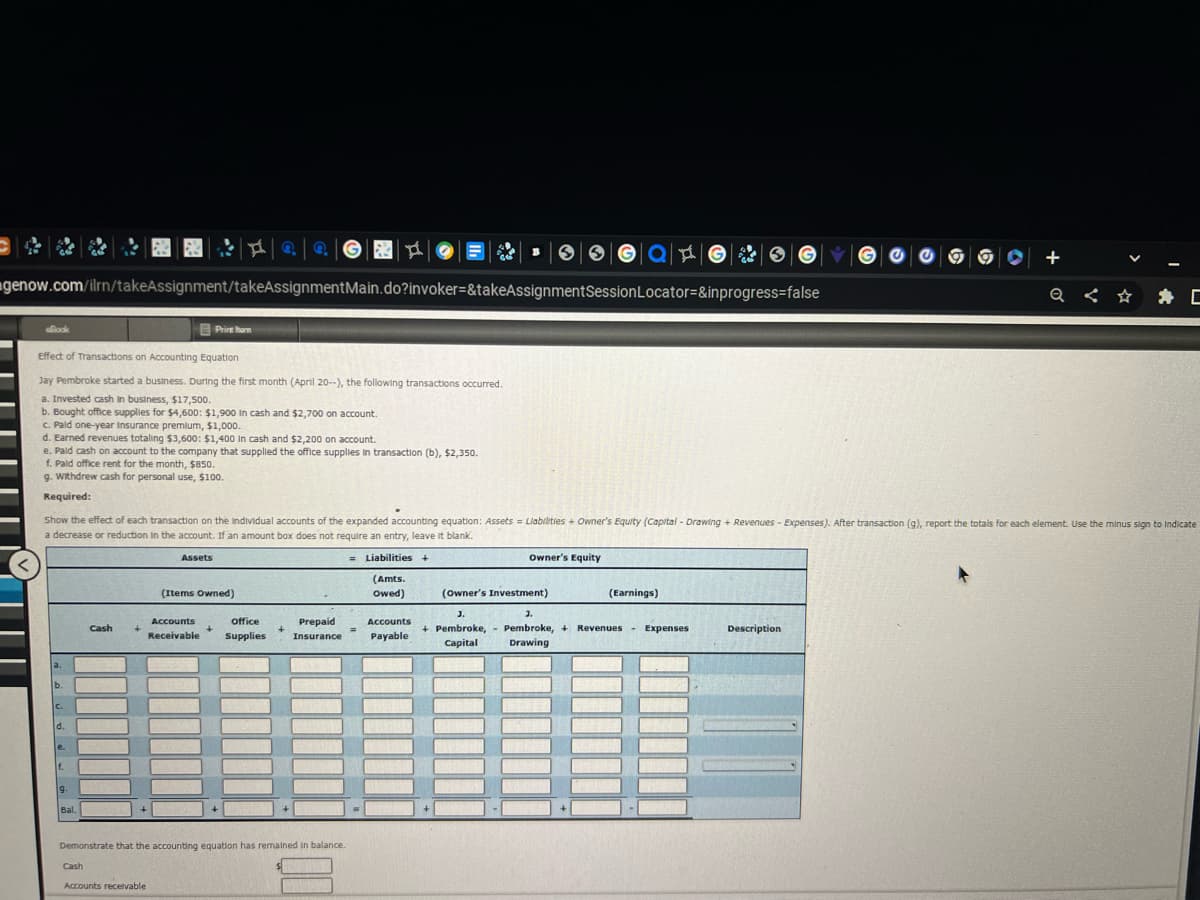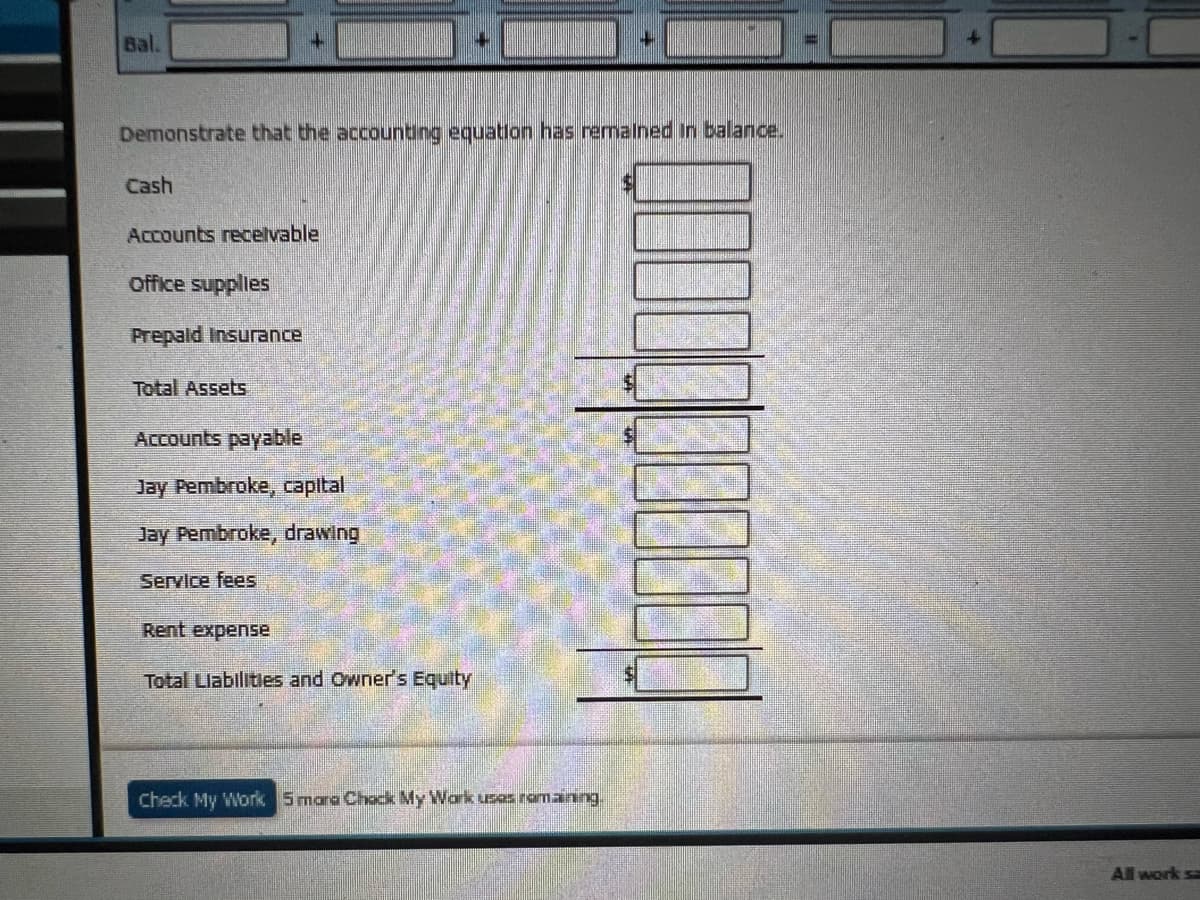Show the effect of each transaction on the individual accounts of the expanded accounting equation: Assets = Liabilities + Owner's Equity (Capital - Drawing + Revenues - Expenses). After transaction (g), report the totals for each element. Use the minus sign to Indicate a decrease or reduction in the account. If an amount box does not require an entry, leave it blank. = Liabilities + a. b. C. d. 9- Bal Cash Assets (Items Owned) Accounts Receivable + office Supplies + Prepaid Insurance Demonstrate that the accounting equation has remained in balance. (Amts. Owed) Accounts Payable Owner's Equity (Owner's Investment) J. + Pembroke, Capital (Earnings) 2. Pembroke, +Revenues Expenses Drawing Description
Show the effect of each transaction on the individual accounts of the expanded accounting equation: Assets = Liabilities + Owner's Equity (Capital - Drawing + Revenues - Expenses). After transaction (g), report the totals for each element. Use the minus sign to Indicate a decrease or reduction in the account. If an amount box does not require an entry, leave it blank. = Liabilities + a. b. C. d. 9- Bal Cash Assets (Items Owned) Accounts Receivable + office Supplies + Prepaid Insurance Demonstrate that the accounting equation has remained in balance. (Amts. Owed) Accounts Payable Owner's Equity (Owner's Investment) J. + Pembroke, Capital (Earnings) 2. Pembroke, +Revenues Expenses Drawing Description
College Accounting, Chapters 1-27
23rd Edition
ISBN:9781337794756
Author:HEINTZ, James A.
Publisher:HEINTZ, James A.
Chapter2: Analyzing Transactions: The Accounting Equation
Section: Chapter Questions
Problem 4SEB: EFFECTS OF TRANSACTIONS (BALANCE SHEET ACCOUNTS) Jon Wallace started a business. During the first...
Related questions
Topic Video
Question

Transcribed Image Text:@@
genow.com/ilrn/takeAssignment/takeAssignmentMain.do?invoker=&takeAssignment
Book
Effect of Transactions on Accounting Equation
Jay Pembroke started a business. During the first month (April 20--), the following transactions occurred.
a. Invested cash in business, $17,500.
b. Bought office supplies for $4,600: $1,900 In cash and $2,700 on account.
c. Pald one-year Insurance premium, $1,000.
d. Earned revenues totaling $3,600: $1,400 In cash and $2,200 on account.
e. Pald cash on account to the company that supplied the office supplies in transaction (b), $2,350.
f. Pald office rent for the month, $850.
g. Withdrew cash for personal use, $100.
Required:
a.
b.
C.
e.
f.
9.
Bal.
Show the effect of each transaction on the Individual accounts of the expanded accounting equation: Assets = Liabilities + Owner's Equity (Capital - Drawing + Revenues - Expenses). After transaction (g), report the totals for each element. Use the minus sign to Indicate
a decrease or reduction in the account. If an amount box does not require an entry, leave it blank.
=Liabilities +
Cash
Cash
+
Print harn
hom
Assets
Accounts receivable
(Items Owned)
Accounts
office
Receivable Supplies
+
+
Demonstrate that the accounting equation has remained in balance.
Prepaid
Insurance
▸
=
(Amts.
Owed)
Accounts
Payable
Ga |A|
Session Locator=&inprogress=false
(Owner's Investment)
J.
+ Pembroke,
Capital
Owner's Equity
(Earnings)
SGY
3.
Pembroke, +Revenues Expenses
Drawing
+
Description
V
Q < ☆
C

Transcribed Image Text:Bal.
Demonstrate that the accounting equation has remained in balance.
Cash
Accounts receivable
office supplies
Prepaid Insurance
Total Assets
Accounts payable
Jay Pembroke, capital
Jay Pembroke, drawing
Service fees
4
Rent expense
Total Liabilities and Owner's Equity
bum
Check My Work 5 mara Chack My Work uses ramaining.
All work s
Expert Solution
This question has been solved!
Explore an expertly crafted, step-by-step solution for a thorough understanding of key concepts.
This is a popular solution!
Trending now
This is a popular solution!
Step by step
Solved in 3 steps

Knowledge Booster
Learn more about
Need a deep-dive on the concept behind this application? Look no further. Learn more about this topic, accounting and related others by exploring similar questions and additional content below.Recommended textbooks for you

College Accounting, Chapters 1-27
Accounting
ISBN:
9781337794756
Author:
HEINTZ, James A.
Publisher:
Cengage Learning,

College Accounting (Book Only): A Career Approach
Accounting
ISBN:
9781305084087
Author:
Cathy J. Scott
Publisher:
Cengage Learning

College Accounting (Book Only): A Career Approach
Accounting
ISBN:
9781337280570
Author:
Scott, Cathy J.
Publisher:
South-Western College Pub

College Accounting, Chapters 1-27
Accounting
ISBN:
9781337794756
Author:
HEINTZ, James A.
Publisher:
Cengage Learning,

College Accounting (Book Only): A Career Approach
Accounting
ISBN:
9781305084087
Author:
Cathy J. Scott
Publisher:
Cengage Learning

College Accounting (Book Only): A Career Approach
Accounting
ISBN:
9781337280570
Author:
Scott, Cathy J.
Publisher:
South-Western College Pub

Excel Applications for Accounting Principles
Accounting
ISBN:
9781111581565
Author:
Gaylord N. Smith
Publisher:
Cengage Learning

Financial And Managerial Accounting
Accounting
ISBN:
9781337902663
Author:
WARREN, Carl S.
Publisher:
Cengage Learning,

Corporate Financial Accounting
Accounting
ISBN:
9781305653535
Author:
Carl Warren, James M. Reeve, Jonathan Duchac
Publisher:
Cengage Learning